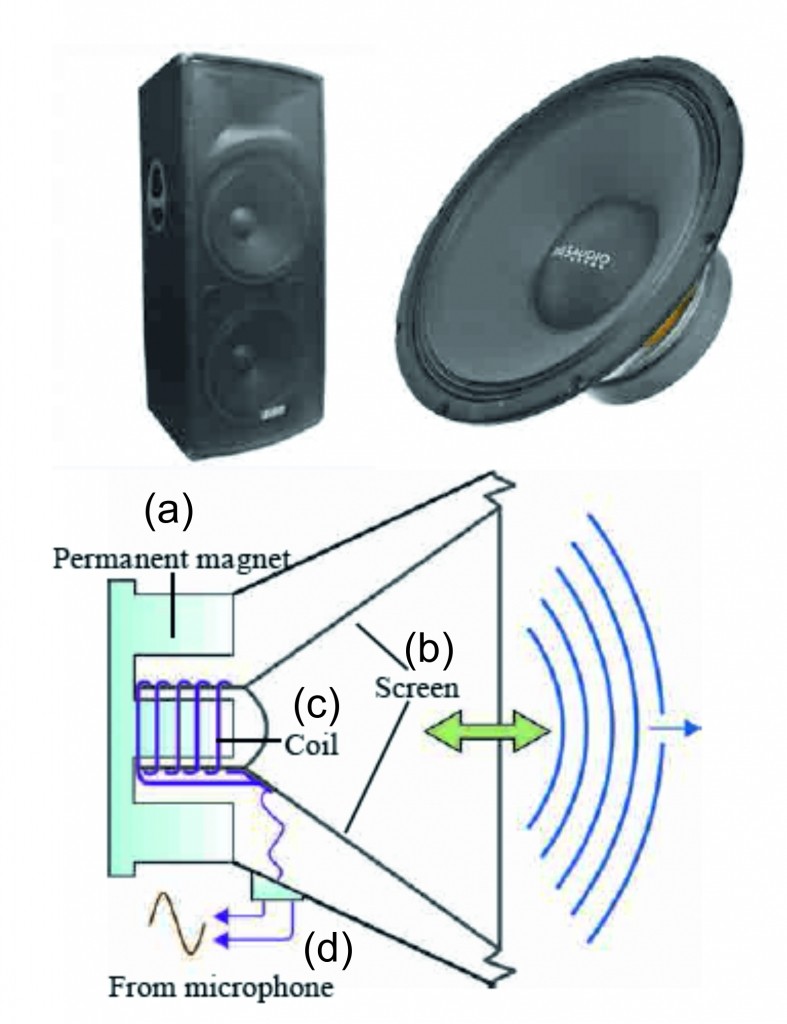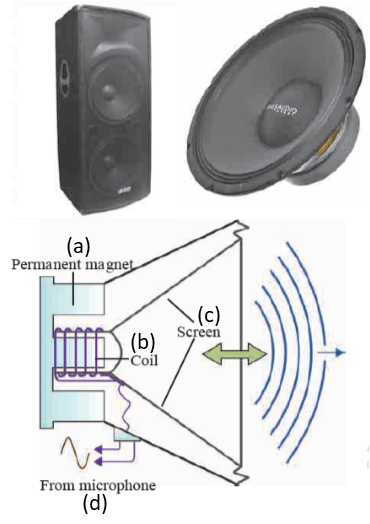Balbharti Maharashtra State Board Class 8 Science Solutions Chapter 15 Sound Notes, Textbook Exercise Important Questions and Answers.
Q.1. Fill in the blank and rewrite the completed statements 10
1. One compression and one rarefaction together forms one of the wave.
Ans One compression and one rarefaction together forms one Cycle of the wave.
2. Generation and Propagation of sounds requires a …………… .
Ans Medium
3. Different sound notes have different …………… .
Ans Different sound notes have different frequencies.
4. The total number of compressions and rarefactions produced per second in a sound wave is 500Hz. The frequency of the sound wave is …………… .
Ans The total number of compressions and rarefactions produced per second in a sound wave is 500 Hz. The frequency of the sound wave is 500 Hz.
5. The frequency of sound is measured in …………… .
Ans The frequency of sound is measured in Hertz.
6. Medium is for generation of sound.
Ans Medium is necessary for generation of sound.
7. In humans, sound is produced in …………… .
Ans In humans, sound is produced in Larynx.
8. The region in a sound wave, with higher pressure and density is called and that with low pressure
and density is called …………… .
Ans The region in a sound wave, with higher pressure and density is called compression and that with low pressure and density is called rarefaction.
9. In loudspeaker, …………… energy is converted into energy.
Ans In loudspeaker, electrical energy is converted into sound energy.
10. In tuning fork vibration, the region having high air pressure and density is called …………… .
Ans In tuning fork vibration, the region having high air pressure and density is called Compression.
Q. 2. Find the odd one out 2
1. Bell jar, vacuum pump, electric bell, prong.
Ans Prong – its an part of tuning fork rest all are the term used in Propagation of sound and Medium.
2. Vocal cord, larynx, pharynx, magnet
Ans Magnet – its an part of sound produced by loud speaker rest all are the parts of human body which helps in production of sound.
Q. 3. Extra data 9
- In string based instruments, the …………… of vibration of the string is changed by changing the ……………
on the string and/or by changing the length of the string using fingers. This results in generation of
different ……………
Ans In string based instruments, the Frequency of vibration of the string is changed by changing the Tension on
the string and/or by changing the Vibrating length of the string using fingers. This results in generation of different Notes.
- What do you feel when you produce a sound ‘bho…bho..’ just like a dog-barking and ‘meow.. meow..’ just like a mewing cat.
Ans Carefully notice the tension on the vocal cords, when you produce these sounds.
Its due to the air force created by lungs due to which the vocal vord vibrate and tension is created.
- Give scientific reasons for sound produced by human.
Ans i. Two vocal cords, are stretched across the voice box or larynx in such a way that it leaves a narrow slit between them for the passage of air.
.ii. When the lungs force air through the slit, the vocal cords vibrate, producing sound.
4..The diagram given below shows the larynx in human.
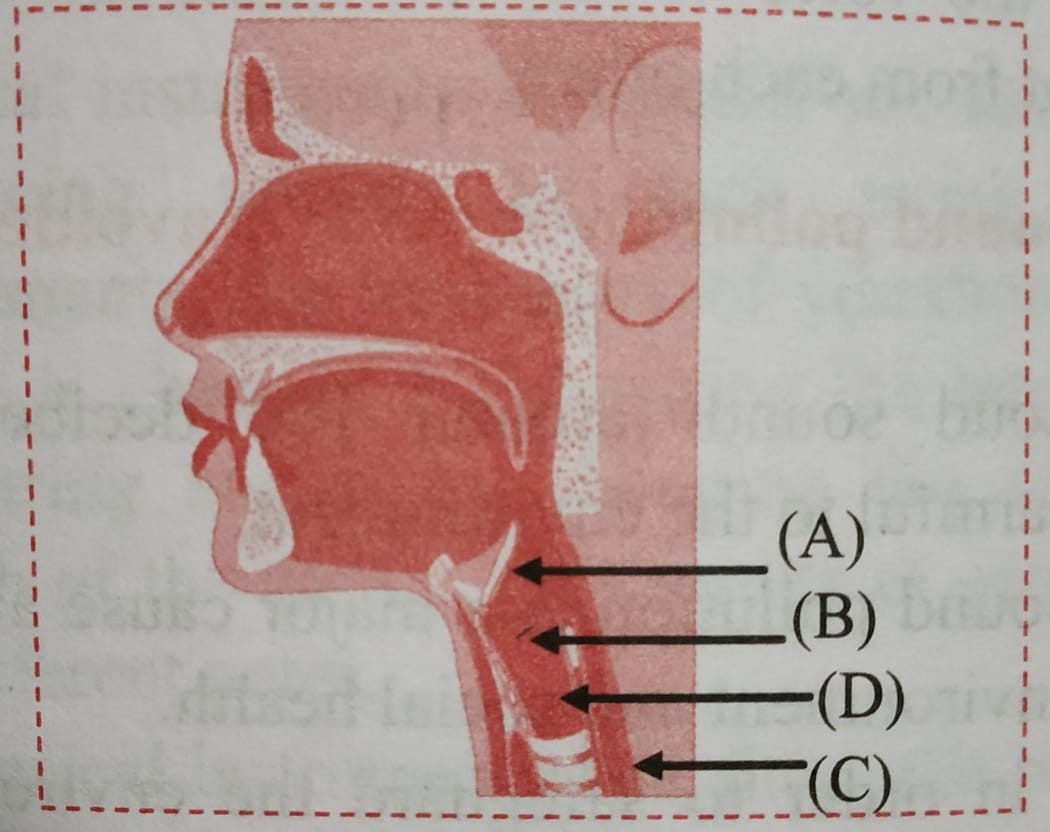
Ans A → Epiglottis B → Vocal cords C → Oesophagus D → Trachea
5. The diagram shown below represents the internal construction of a loudspeaker.

Ans A → Screen B → Input from microphone C → Permanent magnet D → Coil
6. Give scientific reason for sound generation by loud speaker
Ans i. If two magnets are brought near each other, they move depending on their positions.
i.A coil is wound around it, depending on the magnetic field created due to the coil, the coil moves back and forth.
ii.Due to back and forth motion of the loudspeaker screen, sound waves are produced in air.
7. The diagram given below represents a tuning fork.

Ans A → Prong, B → Stem
8. Write the difference between compressions and rarefaction
Ans
| Compressions | Rarefaction |
| A compression is a region in longitudinal waves where the particle are closest together. | A rarefraction is a region in longitudinal waves where the particle are furthest apart. |
- Draw and label the Internal construction of a loudspeaker.
Ans
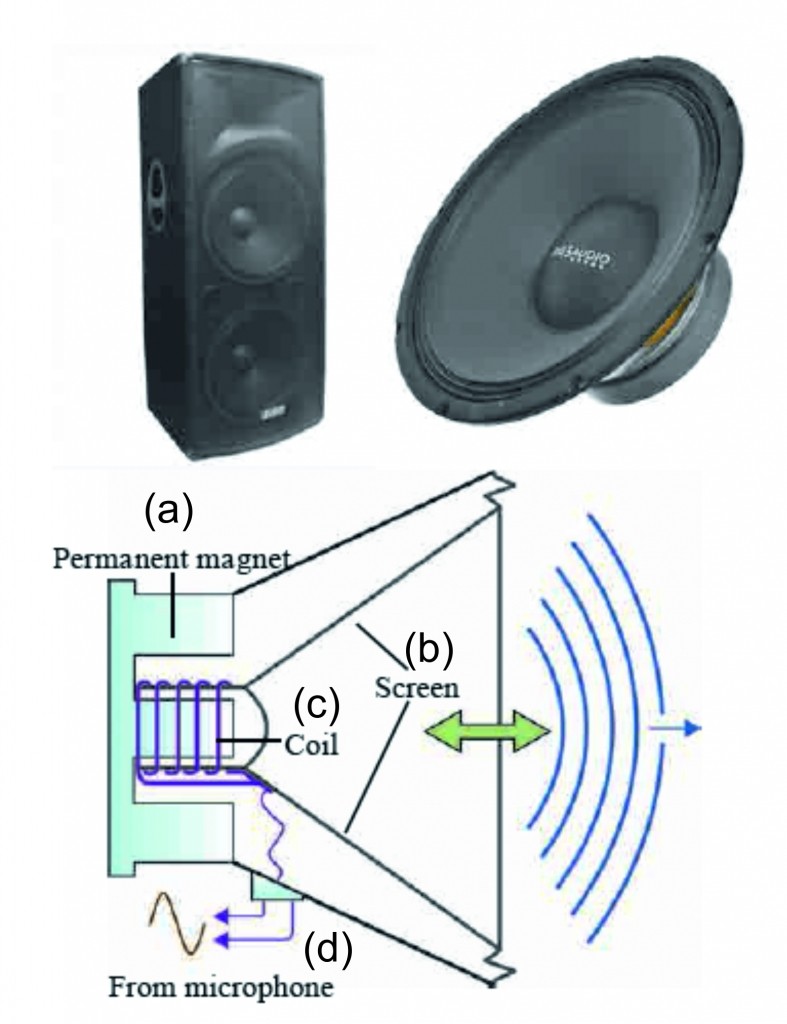
Q. 4. Match the pair 3
1.
| Column – A | Column – B |
| i. Human larynx | a. Vibrations of screen |
| ii. Loudspeaker | b. Vibrations in air column |
| c. Vibrations in vocal cords |
Ans
| i. Human larynx | Vibrations in vocal cords |
| ii. Loudspeaker | Vibrations of screen |
2
| Column – A (Note) | Column – B (Frequency) |
| i. sa | a. 256 |
| ii. ni | b. 246 |
| c. 480 | |
| d. 259 |
Ans
| i. S2 | 256 |
| ii. ni | 480 |
3
| Column – A | Column – B |
| i. Jal tarang | a. Vibration of metal arms |
| ii. Tuning fork | b. Vibrations in strings |
| c. Vibrations in air column |
Ans
| i. Jal tarang | Vibrations in air column |
| ii. Tuning fork | Vibration of metal arms |
Q.5. State True or False 5
1. The vibration of tuning fork results in compressions and rarefactions in air.
Ans True
2. The frequency of a tuning fork is decided by the dimensions (length, thickness) of the prongs.
Ans True
3. Region in which air is at low pressure and low density is called compression.
Ans False – Region in which air is at low pressure and low density is called rarefaction.
4. Due to back and forth motion of the prongs of the tuning fork, sound waves are produced.
Ans True
5. The sound produced is not affected by change in frequency of sound.
Ans False – The sound produced is affected by change in frequency of sound.
Q.6. Name the following 8
1. Identify the instruments :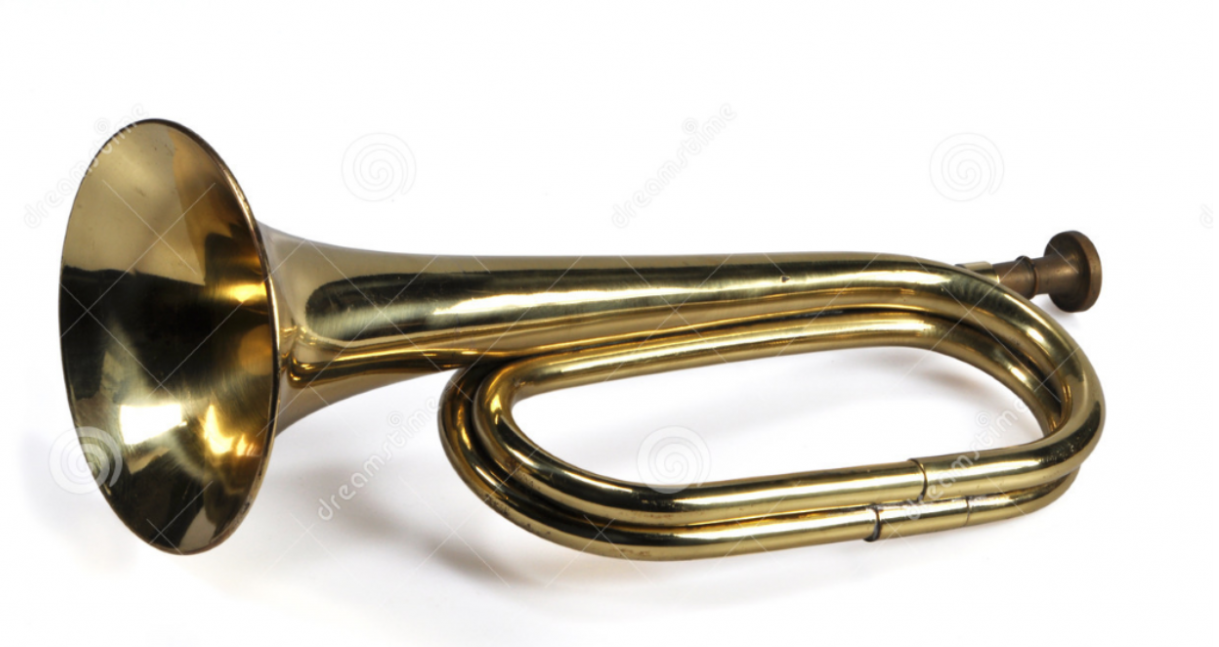
Ans Trumpet
2. Identify the instruments
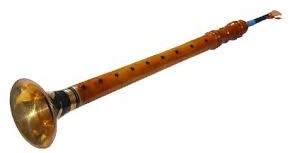
Ans Sanie
3. Identify the instruments
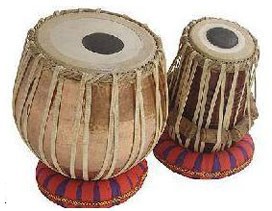
Ans Tabala
4. Identify the instruments

Ans Flute
5. Identify the instruments

Ans Santoor
6. Identify the instruments
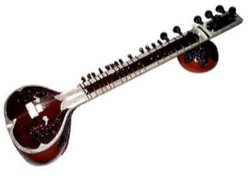
Ans Sitar
7. Identify the instruments
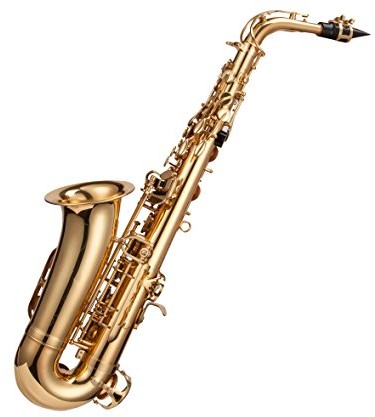
Ans Saxphone
8. Identify the instruments.
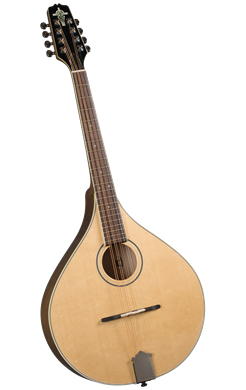
Ans Mandolin
Q. 7. Answer in one sentence 5
1. Define compression
Ans The region in which air is at high pressure and high density is called compression.
2. Why in musical instrument like flute there is hole ?
Ans In musical instruments like flute, the holes on the flute are opened or closed to change the length of vibrating air column in the flute.
3. How can different node be generated in flute?
Ans In flute, different notes can be generated by changing the way of air-blowing also.
4. Define frequency of the sound wave.
Ans Number of such cycles that are produced in the air (or other medium) per second is called as the frequency of the sound wave.
5. What happens to the frequency of the waves in the flute?
Ans : It changes and it results in the production of different notes.
Q. 8. Multiple Choice Questions (Activity) 2
1. Vocal cords are mm in length in male.
a. 15 b. 10 c. 20 d. 17
Ans Option c.
2. In string based instrument, frequency of vibration of string can be changed by changing ……………
a. Pitch of string b. Vibrating length of string
c. Tension of string d. Both (i) and (ii)
Ans Option c.
Q.9. Multiple Choice Questions (Experiment) 2
1. The waves used in do not need any medium for propagation.
a. Cell phone b. Tuning fork
c. Both i. and ii. d. None of the above.
Ans Option a.
2. Sound level of loudspeaker is decibels.
a. 150 b. 90 c. 100 d. None of the above
Ans Option c.
Q.10.Write Short Notes 4
1. Write note on production of sound.
Ans ii. . A periodic motion of the prongs creates compression and rarefaction in the air and these are propagated away from the prongs.
ii. These are nothing but the sound waves. When these waves reach our ear, the ear-drum vibrates.
iii. Accordingly, specific signals reach the brain and we get a sense of hearing a sound.
2. Write note on sound and music.
Ans i. Sound waves of different frequencies produce different sound notes.
ii. In the field of music, various musical instruments are used for creation of sound notes.
Iii .This includes instruments like sitar, violin, guitar which use strings for production of sound and instruments like flute, shehnai which use air blown into pipes for the production of sound.
Q.11. Distinguish between 2
1. Sound Produced by Human and Sound generation by loudspeaker
Ans
| Sound Produced by Human | Sound generation by loudspeaker | ||
| i. | It includes Vocal cord voice box and larynx | i. | It includes magnet and coil. |
| ii. | Lungs force air for vibration of vocal cord | ii. | Coil generate magnetic field for its vibration |
| Human can’t produce sound up to 100 decibels | Loudspeaker can produce sound up to 100 decibels | ||
| iii. | iii. | ||
| iv. | Sound produced by human is not harmful | iv. | Sound produced by loudspeaker is harmful |
Q.12. Give scientific reasons: 4
1. It is essential to change the tension on the vocal cords, as we produce different sound notes from our larynx.
Ans i.. In humans, sound is produced in the larynx (voice box) situated at the upper end of the windpipe.
ii. Two vocal cords are stretched across larynx leaving a narrow slit between them for the passage of air.
iii. When the lungs force air through the slit, the vocal cords vibrate, producing sound.
Iv. Frequency of the sound generated depends upon the tension of the vocal cords which are controlled by muscles in the larynx.
Hence, it is essential to change the tension of the vocal cords, as we produce different sound notes from our larynx.
2. How is sound produced in a human larynx and a loudspeaker?
Ans a. Sound production in humans:
i. In humans, sound is produced in the larynx (voice box) situated at the upper end of the windpipe.
ii. Two vocal cord are stretched across the larynx leaving a narrow slit between them for the passage of air.
iii. When the lungs force air through the slit, the vocal cords vibrate, producing sound.
iv. Muscles attached to the vocal cords can make the cords tight or loose. When the vocal cords are tight and thin and thin, the type or quality of sound produced is different than the sound produced when vocal cords are loose and thick.
Sound production in loudspeaker:
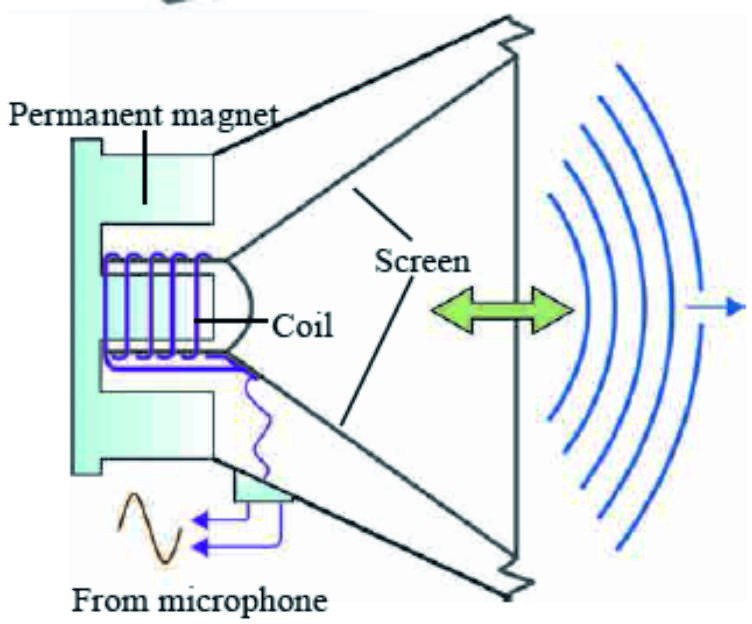
i. Loudspeaker consists of a permanent magnet with a coil wound around it.
ii. When current flows through the coil, magnetic field is generated around the coil.
iii. Due to this magnetic field, the coil moves back and forth.
iv. The frequency and amplitude of the movement of the coil depends on the variation in the current flowing through the coil.
v. Due to the motion of the coil, the conical screen attached to the coil also starts moving back and forth.
vi. This back and forth movement of loudspeaker screen gives rise to sound waves in air.
Q.13. Give examples 2
1. What are the frequencies of musical notes in the ‘madhya saptak’? and mentioned the table with its frequency.
Ans i. ‘sa’, ‘re’, ‘ga’, ma’, ‘pa’, ‘dha’, ‘ni’ ii.
|
Note |
Frequency (Hz) |
| sa | 256 |
| re | 280 |
| ga | 312 |
| ma | 346 |
| pa | 384 |
| dha | 426 |
| ni | 480 |
Q.14. Activity based questions.(2 mks) 2
1. Label the given diagram.
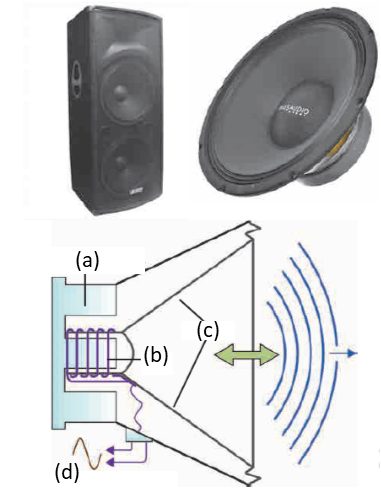
Ans
Q.15. Activity based question (3 mks) 6
1. . Label the diagram of cycles of compression and rarefaction in a sound wave and change in air pressure.
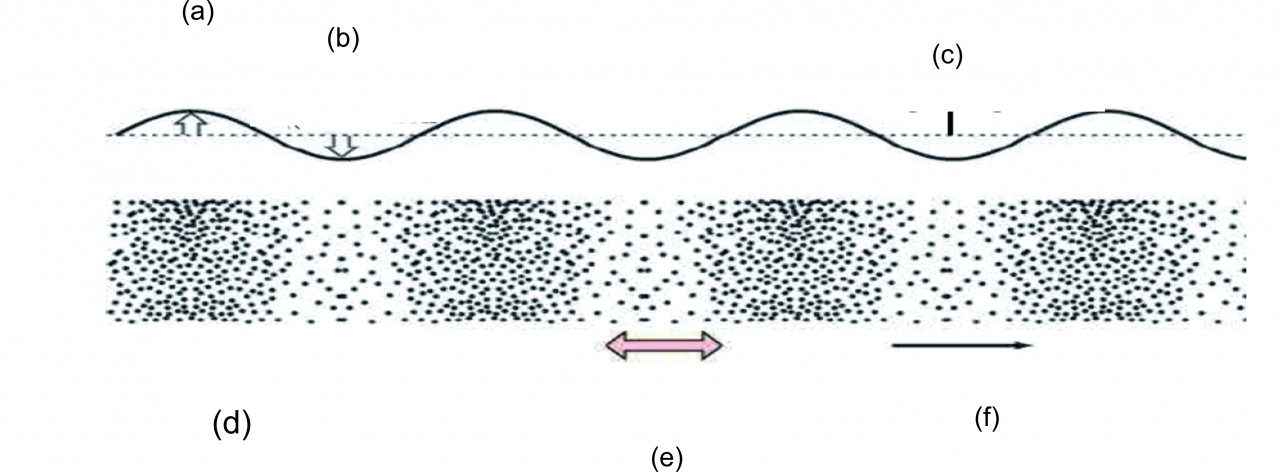
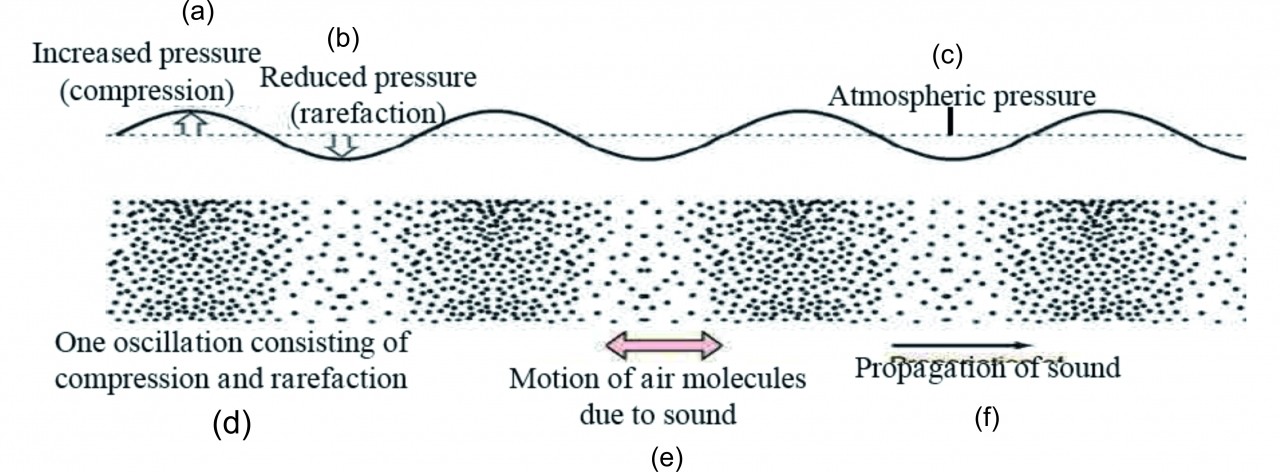
Ans
2. Complete the following paragraph:
(foodpipe, larynx, slit, Narrow, windpipe, Voice box, gap, Two vocal cords)
In the humans, sound is produced in the …………….. , a hard bump that seems to move when you are swallowing food . It is at the Upper end of the ……………….. . ……………… are stretched across the
……………………. or larynx in such a way that it leaves a ……………… between them for the passage of
………………..
Ans : In the humans, sound is produced in the larynx, a hard bump that seems to move when you are swallowing food . It is at the Upper end of the windpipe. Two vocal cords are stretched across the Voice box or larynx in such a way that it leaves a slit between them for the passage of Narrow.
Q.16. Explain the statement. 3
1. Take 6-7 glass cups. Arrange them in a line and fill them with water with gradually increasing water level from one end to other. Take a pencil and strike the cups sequentially. The sound generated by each cup will be different. Why it is so?
Ans i. When a cup is struck, waves are set up in the air column above the water level in the cup
ii. The frequency of the generated wave depends on the height of the air column inside the glass cup
iii. Since the water level in each glass is different, the height of the air column in each glass is also different
iv. Therefore, the frequency of sound generated by each glass cup will also be different
v. So, the sound generated is different
Q.17. Draw / Label the diagram 2
1. Draw the diagram for Production of sound by tuning fork.
Ans
Q.18. Complete the incomplete diagram 3
1. Label the diagram for Propagation of sound and Medium
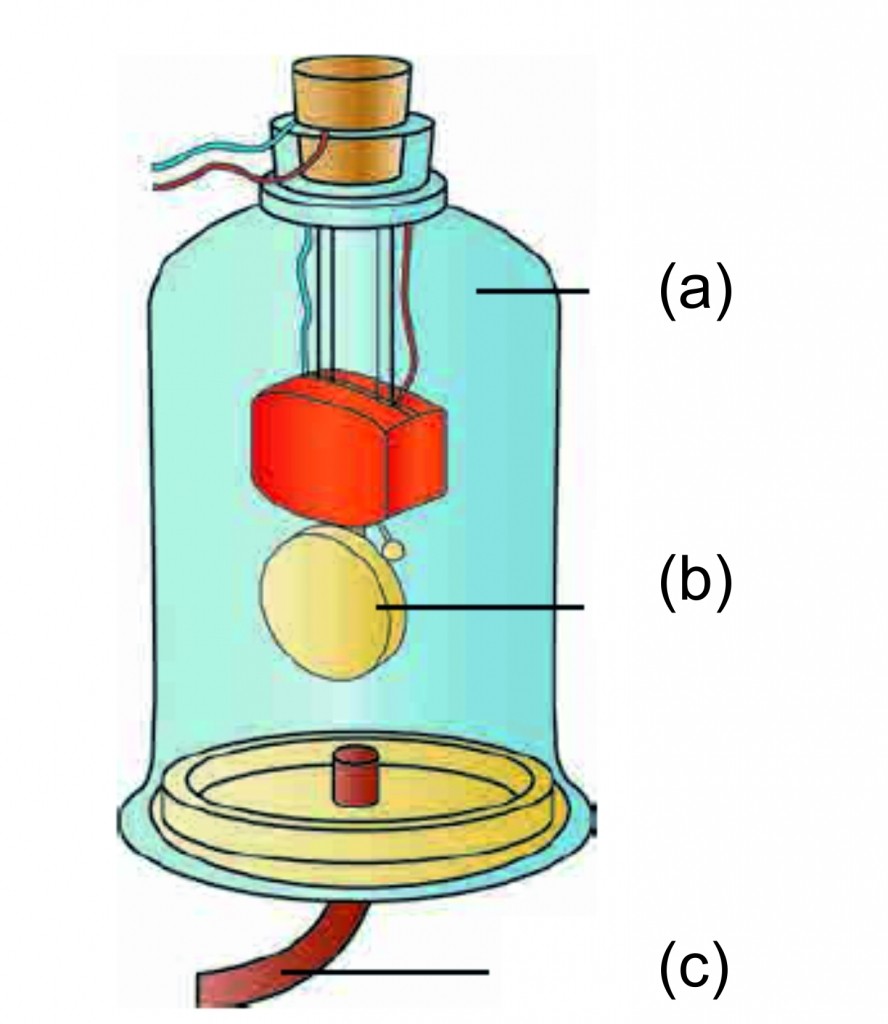
Ans:
Q.19. Explain with the help of examples 3
1. Explain frequency of sound generated by each glass cup will also be different. So, the sound generated is different?
Ans i.. When a cup is struck, waves are set up in the air column above the water level in the cup
ii. The frequency of the generated wave depends on the height of the air column inside the glass cup
iii. Since the water level in each glass is different, the height of the air column in each glass is also different.
Therefore, the frequency of sound generated by each glass cup will also be different
iv. So, the sound generated is different
Q. 20. Draw a well labeled diagram and explain. 5
1. Explain the experiment, with neat diagram, to prove the following:
‘Sound needs material medium for propagation.’
 Ans Aim: To verify that a material medium is essential for the propagation of sound waves with the help of the bell jar experiment.
Ans Aim: To verify that a material medium is essential for the propagation of sound waves with the help of the bell jar experiment.
Procedure:
i. Take an inverted glass jar and place it on a smooth surface. Using a tube, connect the jar to a vacuum pump. Fit an electric bell in the jar as shown in the figure given above.
ii. At the beginning of the experiment, the vacuum pump is switched off and the bell-jar contains air. Now switch on the key to electric bell. The bell starts ringing and the ringing can be heard outside the bell jar.
iii. Take the air out of the glass jar with the help of a vacuum pump.
Observation:
i. when air is steadily taken out of the glass jar, the sound of the bell goes on decreasing and after a certain time the sound becomes inaudible. However, vibrations of gong of the bell can be seen from outside.
Conclusions:
i. A material medium is required for the propagation of sound waves.
ii. Sound cannot travel in vacuum.
Q. 21. Answer the following in detail 5
 1
1
Ans :
Label the above given diagram and explain.
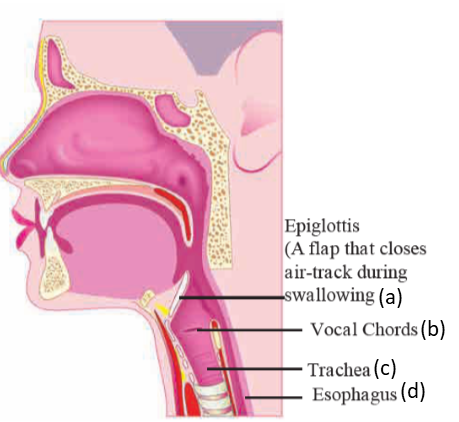
i. In the humans, sound is produced in the larynx. While swallowing food, we can feel with our finger a hard bump that seems to move
ii. This is nothing but larynx. As shown in Figure 15.5, it is at the upper end of the windpipe
iii. Two vocal cords, are stretched across the voice box or larynx in such a way that it leaves a narrow slit between them for the passage of air
iv. When the lungs force air through the slit, the vocal cords vibrate, producing sound
v. Muscles attached to the vocal cords can make the cords tight or loose
vi. When the vocal cords are tight and thin, the type or quality of voice is different
